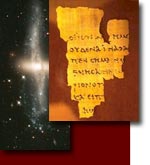| Site Map | Contacts | Links | Newsletter | |
Genesis:
Genesis 37-50 - The Story of Joseph
It seems most likely that Joseph rose to power during the time of the Hyksos, or just before in the 12th Dynasty when many Asiatics came into Egypt. It also seems most likely that the Exodus from Egypt should be equated with the expulsion of the Hyksos. Not all the Hyksos were Israelites. It says in Exodus that a great mixed multitude came out of Egypt with Moses (Exodus 12:38).
The Greek name "Hyksos" was coined by Manetho to identify his fifteenth Dynasty of Asiatic rulers of northern Egypt. The word comes from the Egyptian Hk3(w) h3swt, which means "ruler(s) of foreign countries" (Meyers 1997, 3:133) which Manetho mistranslated as "Shepherd Kings". The Hyksos were of West Semitic background probably from southern Palestine who migrated down into northern Egypt during the 12th and 13th dynasties. At first they lived peacefully with the Egyptians until the deterioration of Egypt's power when in 1648 BC they captured the Egyptian capital at Memphis.
The Hyksos made Avaris their capital which is modern Tell ed-Dab'a, which was later known as Piramesse (Exodus 1:11). "Avaris" is the Greek term for the Egyptian Hwt-w'rt meaning "mansion of the desert plateau" (Meyers 1997 3:134). Other important Hyksos cities were Tell el-Yahudiyeh (meaning "mound of the Jews") known for its distinctive black and whiteware, and Tell el-Maskhuta (probably Succoth in Exodus 1:11).
Austrian Manfred Beitak excavating Tell ed Dab'a, the ancient capital of the Hyksos, between 1984 to 1987 discovered a palace and garden dating back to the 12th Dynasty with a tomb containing a statue of an Asiatic with a mushroom hairstyle that some scholars think might be Joseph (Aling 1995, 33; 1981; Rohl 1995, 327-367). Much more evidence is needed to claim for certain that this is Joseph's tomb (Redford 1970).
There is an interesting study done by Barbara Bell on the records of the Nile's water levels. She concluded that in the middle of the 12th Dynasty there were erratic Nile water levels that caused crop failure (Bell 1975, 223-269). Could this be Joseph's famine?
There is "The Tradition of Seven Lean Years in Egypt" written during the Ptolemaic period about the reign of Djoser that states:
To let thee know. I was in distress on the Great Throne, and those who are in the palace were in heart's affliction from a very great evil, since the Nile had not come in my time for a space of seven years. Grain was scant, fruits were dried up, and everything which they eat was short. Every man robbed his companion (ANET 1969, 31).
The Story of Two Brothers is an Egyptian text that dates to about 1225 BC that is very similar to the story of Joseph. This tale tells how a young man was falsely accused of a proposal of adultery by the wife of his older brother after he had rejected her advances (ANET 1969, 23-25; Lichtheim 1976, 2:203-211).
In the 12th Dynasty Egyptian tomb of Khunum-hotep (1890 BC) at Beni Hasan is pictured a caravan of 37 Asiatics arriving in Egypt trading black eye paint (stibium) from the land of Shutu (ANEP 1969, fig. 3). The leader is named Ibsha and bears the title "ruler of foreign lands" from which the name "Hyksos" is derived (ANET 1969, 229). The land of Shutu is probably an ancient term for Gilead (Aharoni 1979, 146). The Ishmaelites who took Joseph down to Egypt came from Gilead through Dothan (Genesis 37:25).
In the Book of Sothis which Syncellus believed was the genuine Manetho it gives the specific time when Joseph rose to power under Hyksos king, Aphophis who ruled 61 years. It says: Some say that this king (Aphophis) was at first called Pharaoh, and that in the 4th year of his kingship Joseph came as a slave into Egypt. He appointed Joseph lord of Egypt and all his kingdom in the 17th year of his rule, having learned from him the interpretation of the dreams and having thus proved his divine wisdom (Manetho 1940, 239).
Halpern has concluded, "Overall, the Joseph story is a reinterpretation of the Hyksos period from an Israelite perspective" (1992, 98).
